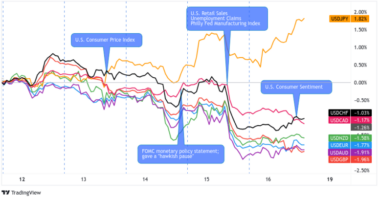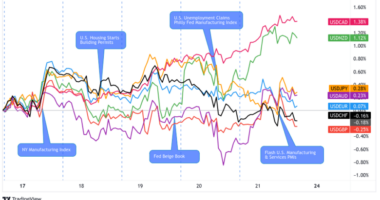Mixed performance from the Greenback this week, overall leaning towards positive at the Friday close.
Global risk sentiment was the main driver of price action, which was generally positive after the big COVID-19 vaccine news on Monday and account for USD’s positive gains against the safe haven / low-yielding currencies, while falling against the comdolls.
But by the end of the week, it was a slight shift in risk sentiment and counter currency flows (mainly a weakening CAD on falling oil prices) that edged USD into the green overall.


United States Headlines and Economic data
Monday:
Biden defeats Trump for White House, says ‘time to heal’
The big market driver of the week came on Monday from Pfizer / BioNTech, announcing that their COVID vaccine is more than 90% effective. This sparked a big risk-on move across the financial markets as traders priced in the odds of an economic recovery coming sooner rather than later. This sentiment did fade by the Monday U.S. session, but lingered on to influence the markets through most of the week. Volatility in the Greenback spiked higher on the news, but we saw a mixed performance as it gained against the safe havens and fell against the Comdolls.
Fed’s Mester says all emergency lending facilities should be extended – “I’m very comfortable with where policy is now” and “there’s more we can do” if the economy needs additional help, Ms. Mester told reporters in a media conference call.
In first for Fed, U.S. central bank says climate poses stability risks – “Chronic hazards, such as slow increases in mean temperatures or sea levels, or a gradual change in investor sentiment about those risks, introduce the possibility of abrupt tipping points or significant swings in sentiment,” Brainard said.
U.S. still faces possible default wave, asset declines due to pandemic: Fed – “As many households continue to struggle, loan defaults may rise, leading to material losses” for lenders, the Fed said in its latest biannual Financial Stability Report.
Share of Mortgage Loans in Forbearance Decreases to 5.67 Percent – “With declines in the share of loans in forbearance across the board, the data this week align well with the positive news from October’s jobs report, which showed a gain of more than 900,000 private sector jobs, and a 1 percentage point decrease in the unemployment rate,” said Mike Fratantoni, MBA’s Senior Vice President and Chief Economist.
Tuesday:
Fed’s Kaplan says he is concerned about next two quarters – “Fed’s Kaplan sees downside risk from virus resurgence.”
U.S. Small-business owners grow more anxious, NFIB finds, after record COVID-19 surge – “The coronavirus still poses the biggest risk in light of record increase in cases that could trigger more government limits on business. Even a partial reinstatement of restrictions could be harmful, especially after the end of a federal program in July that provided struggling small businesses with a financial lifeline.”
Fed’s George says growth to moderate, policy appropriate – “The key risk to growth, she said in a virtual event put on by Monmouth University, is the coronavirus, which has put women and people of color out of work at higher rates than others, and continues to weigh on some sectors more than others.”
Fed’s Rosengren says fiscal aid should include help for state and local governments
Wednesday:
U.S. Mortgage applications decreased 0.5% w/w for the week ending Nov. 6 – MBA
USD began to recover against the comdolls / higher-yielders during the Wednesday and Thursday session, likely a move supported by a broad shift in risk sentiment towards negative. It’s likely traders were coming off vaccine news highs and focusing on the rising COVID cases in Europe and the U.S., as well as the falling odds of a new stimulus bill coming from the U.S. government.
Thursday:
U.S. consumer prices unchanged in October – “The Labor Department said on Thursday said the unchanged reading in its consumer price index last month followed a 0.2% increase in September. In the 12 months through October, the CPI climbed 1.2% after increasing 1.4% in September.”
Home prices in the U.S. increase at the fastest rate since 2013 – “Prices for single-family homes across the U.S. increased 12% in the third quarter, the biggest annual jump in seven years, according to the National Association of Realtors.”
Friday:
U.S. Consumer sentiment unexpectedly declines on economic views – “The University of Michigan’s preliminary sentiment index for November decreased to a three-month low of 77 from a final October reading of 81.8, data released Friday showed. The figure matched the lowest estimates in a Bloomberg survey of economists that had called for 82.”
Biden victory in Arizona puts Trump’s longshot challenge further out of reach
Bullard: Changes to Fed asset purchases a ‘longer range’ discussion
NY Fed’s Williams: U.S. economy still in ‘deep hole’ and rising infections pose rise – “Things are looking better, but that’s in context of an economy that took an enormous hit,” Williams said. “Even today unemployment is still very high and we’re still in a deep hole.”








